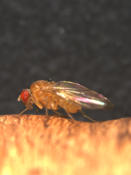| 'Immigrans-tripunctata radiation | |
|---|---|
 | |
| Drosophila innubila of the Drosophila quinaria species group | |
| Scientific classification | |
| Kingdom: | |
| Phylum: | |
| Class: | |
| Order: | |
| Family: | |
| Subfamily: | |
| Genus: | |
| Subgenus: | |
| Species groups | |
See text | |
The immigrans-tripunctata radiation is a speciose lineage of Drosophila flies, including over 300 species. [1] The immigrans-tripunctata radiation is a sister lineage to most other members of the subgenus Drosophila. [2] A number of species have had their genomes or transcriptomes sequenced for evolutionary studies using Drosophila.



